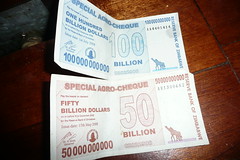The Bretton Woods Conference started the system now known as fixed rate exchange. After the 1944 conference, theUnited Statesattached dollars to gold with one ounce of
gold equal to $35.
The process changed in the 1970s, due to problems with inflation and currencies from other countries. The financial system of any country relates to the law of supply and demand.
As the demand for currency increases, the system undergoes appreciation. When the demand for currency drops, the system goes through depreciation. A country can devalue its currency based on lower demand.
For example, a country might equate 20 of its own currency for one American dollar. After the market fluctuates, the country devalues its money, making 40 of its currency equal to a single American dollar.
Devalued currency occurs in theUnited Statesduring periods of debt or recession. The government prints more money, which is worth less.
The country must have a way of covering its debts, such as with gold. If the country lacks adequate funds, the paper currency is essentially worthless.
A good example of this occurred during the American Civil War. The Confederates printed its own Confederate money. Once the war ended, the devalued money was worth nothing. Even today, the money only has a slight historical value.
American debt rises when the country goes through a recession or depression.Franceunderwent such a change when the country increased minimum wages and benefits for the working class.
The national debt continued rising and the country had no funds to pay back that debt. Fortunately, comparison sites like MoneySupermarket can help you find the best ways to save and make the most of your money when the value of American dollars drops.
Devalued dollars affect you because it reduces the amount of goods and services you can afford. Even simple things, such as buying car insurance or saving money takes more than it did before.
Devalued dollars increase inflation. As the country pumps out more money, stores and businesses increase prices.
You spend more money on the things you need every day, only to find yourself in debt once inflation ends. TheUnited Statesdevalued the dollar in the 1970s and again in 2001. During the 1970s, inflation hit gas stations particularly hard, leading to markups on gas prices and an overall gas shortage.
The 2001 inflation came with increased housing prices, car prices and food prices. Once the bottom fell out, millions of Americans found themselves further in debt. The devalued dollar affects you because it increases costs.
The value of gold, copper, silver and platinum rises, which in turns increases the prices of any items using those metals. Electronics, vehicles, construction and even jewelry prices increase.
Maximize your dollar amount now by saving money on travel expenses, home utilities and anything else you use on a daily basis. Reduce your overall costs before supply and demand causes a drop in the dollar value.
Anytime you use money, including paying student loan bills or insurance bills, you risk spending more than you should. As the dollar value drops, you will find yourself paying even more.
Brought to you by MoneySupermarket.


We see it immediately in the cost of oil because they use the dollar as the exchange rate.